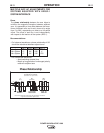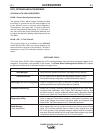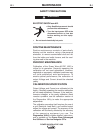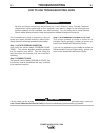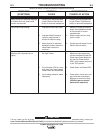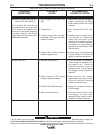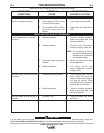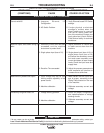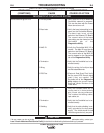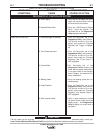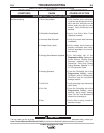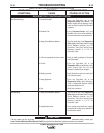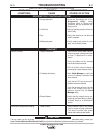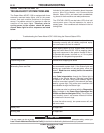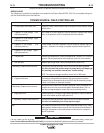
E-6
TROUBLESHOOTING
E-6
POWER WAVE® AC/DC 1000
Observe all Safety Guidelines detailed throughout this manual
If for any reason you do not understand the test procedures or are unable to perform the tests/repairs safely, contact your
Local Lincoln Authorized Field Service Facility for technical troubleshooting assistance before you proceed.
CAUTION
PROBLEMS
(SYMPTOMS)
POSSIBLE
CAUSE
RECOMMENDED
COURSE OF ACTION
Device does not go on Line.
Device goes off line during welding
1. 24v bus power.
2. Baud rate.
3. MAC ID.
4. Termination.
5. Wiring.
6. EDS Files.
1. Interference / Noise.
2. Termination.
3. Shielding.
1. Verify that LED 2 is on when the
DeviceNet network is powered.
This can be done with the Power
Wave turned on or off.
2. Verify the baud rate setting is the
same as the DeviceNet Master.
The baud rate is set via dip
switch on the Ethernet PC Board.
The current value of the baud
rate setting can be viewed on the
DeviceNet tab of the
Diagnostics Utility.
3. Verify the DeviceNet MAC ID is
correct. The Mac ID is set via dip
switch on the Ethernet PC Board.
The current value of the MAC ID
can be viewed on the DeviceNet
tab of the Diagnostics Utility.
4. Verify that the DeviceNet bus is ter-
minated correctly.
5. Verify the wiring of all multi-port taps
and field attachable ends.
6. (Electronic Data Sheet Files) Verify
that the correct EDS files are being
used if they are needed. The
DeviceNet tab of the Diagnostics
Utility displays the current Product
Code and Vendor Revision of the
Power Wave.
1. Verify that DeviceNet cables are not
running next to (in close proximity
with) current carrying conductors.
This includes the welding cables,
input cables, etc.
2. Verify that the DeviceNet bus is ter-
minated correctly.
3. Verify that the cable shielding is cor-
rectly grounded at the bus power
supply. The shield should be tied
into the bus ground at only one point.
DEVICENET-PLC CONTROLLED SYSTEM



